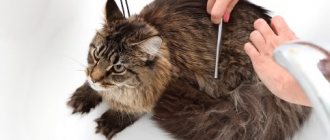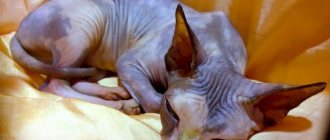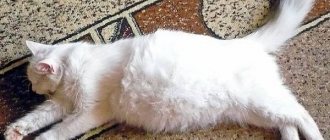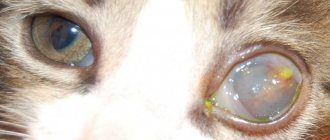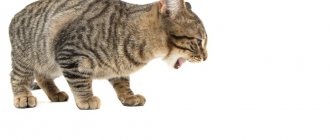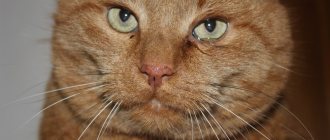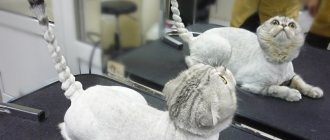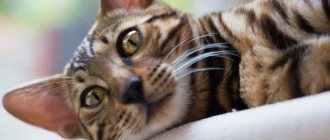Recently, veterinarians have observed a sharp increase in pancreatic diseases in cats. And the most common is pancreatitis. However, statistics show that simply with the development of laboratory tests, which have become available for animals, pancreatitis has become more often diagnosed.
It is no longer confused with other diseases. By analogy with human medicine, in veterinary medicine a simple classification of pancreatitis is accepted - acute pancreatitis and chronic pancreatitis.
Acute pancreatitis in cats is an inflammatory disease of the pancreas that is completely reversible with appropriate treatment.
Feline chronic pancreatitis is an irreversible disease associated not so much with inflammation of the pancreas, but with changes in its tissue. Each form of pancreatitis can be graded according to degrees - weak, moderate and high degree of damage.
For example, if a cat is diagnosed with moderate pancreatitis, then pancreatic necrosis does not occur or it is reversible; with severe pancreatitis, there are not only signs of tissue necrosis, but also systemic damage to the cat’s body.
Causes of the disease
There are many reasons why cats develop pancreatitis:
- Eating disorders. This is the main reason. The disease can be caused by overfeeding a cat, leading to the development of obesity and the appearance of many health problems, low-quality food, and most often, simply the desire to please the pet with “your” food. But smoked, spicy, fried and fatty human food with a lot of salt and artificial additives can only cause illness.
- Heredity. Some cat breeds are more susceptible to this disease than others due to a genetic predisposition caused by numerous breeding interventions.
- Intoxication of various types, from stale food products to the ingestion of alcohol, household chemicals, pesticides, fertilizers and substances containing phosphorus.
- Diseases. The cause of pancreatitis is diabetes mellitus, cholecystitis, liver disease, especially obesity and cirrhosis, toxoplasmosis and other types of protozoan infection, infectious peritonitis and malignant neoplasms.
- Use of medications: antibiotics, especially Tetracycline, diuretics (Furosemide), hormonal and sulfonamide drugs. Also, the use of human medications prohibited for use in cats, for example, Paracetamol, can also cause health problems.
In some cases, the cause of inflammation of the pancreas cannot be accurately diagnosed.
Treatment of pancreatitis in cats.
First, the veterinarian tries to eliminate the main cause of the disease - if it is toxoplasmosis, he treats toxoplasmosis; if it is a viral infection, he uses antiviral drugs. Then, nutrition will be an important component of treatment. You need to endure a 3-4-day fasting regime.
There is no need to force anything into the cat’s mouth, and the cat itself will refuse to eat, since every meal will be accompanied by severe vomiting. Then they begin to introduce water, and then you need to introduce a food high in carbohydrates into the cat's diet, for example, PURINA CNM OM-formula or Hill's feline i/d.
You can also feed your cat through a tube during this period if the disease is accompanied by anorexia.
Taking into account the cat's condition, you can prescribe her analgesics.
Direct drug therapy for pancreatitis includes such groups of drugs as:
- drugs directly aimed at normalizing the activity of the pancreas (for example, “Kontrikal”);
- antiemetic;
- pain reliever;
- antibiotics;
- anti-inflammatory;
In all cases, infusion therapy (drip) is necessary.
Main symptoms
Signs of pancreatitis can be pronounced during an acute attack and blurred during the chronic course of the disease. An acute condition is characterized by a sudden onset with the following manifestations:
- Very strong, unbearable pain, from which the animal can fall into a state of shock.
- Vomiting, which develops in paroxysms, can be uncontrollable even when the cat’s stomach is empty.
- Lethargic state, absence of any reactions. The animal tries to hide in the far corner and avoids people.
- Touching the stomach causes severe pain, and the cat may even bite or scratch the owner.
- Diarrhea or complete absence of bowel movements.
- Yellowing of the mucous membranes due to bile spillage.
- Severe dehydration, due to which the animal's eyes become sunken and the folded skin does not straighten.
In the chronic course of inflammation, the cat periodically begins to vomit, digestion is disrupted, problems with excretion arise, mainly diarrhea is observed, there is no appetite or the animal eats very little.
The cat is lethargic and looks unkempt due to matted and dull, brittle fur.
Forecast
The prognosis for the course of pancreatitis in a cat is related to the severity of the disease - with moderate severity, the prognosis is favorable.
If the severity of pancreatitis is severe, the age of the cat and concomitant diseases must be taken into account. In order to diagnose a cat with pancreatitis, you must definitely go to a veterinary clinic, since only there they will be able to carry out all the necessary studies, and then diagnose pancreatitis in a cat, the symptoms and treatment of which only veterinarians also know.
Diagnostics in a veterinary clinic
In addition to external examination and questioning of owners, the veterinarian will send the cat for the following examinations and tests:
- Ultrasound of the abdominal cavity. It will reveal the condition of the entire digestive system and detect enlargement and inflammation of the pancreas, since in a healthy animal it is almost invisible during such an examination due to its position.
- X-ray examination. It will eliminate the presence of a foreign body in the intestine, fecal blockage, or obstruction.
- Blood analysis. A test is taken for general indicators and biochemistry, since it is necessary to obtain the maximum amount of data about the cat’s health status.
- Diagnostic laparotomy. This method is used if other methods fail to obtain conclusions or the treatment undertaken is ineffective. With the help of surgery, it is possible to exclude the presence of a benign or malignant tumor, cyst, abscess, and also carry out a novocaine blockade. The use of this remedy helps to cope with uncontrollable vomiting.
If the furry pet’s condition is serious, it will be left in the clinic to recover from an acute attack.
Difficulty in diagnosing pancreatitis in a cat.
How to make a diagnosis?
Laboratory tests will help.
The most accurate method is a computed tomography scan of the cat's abdomen. However, although this method is the most informative, it is rarely used due to its high cost. The next method of examining a cat for pancreatitis is ultrasound.
An ultrasound scan can show swelling of the cat's pancreas and a displacement of the stomach and duodenum towards the liver. A definitive diagnosis can be made based on a pancreatic biopsy. Although, after ultrasound has determined the swelling of the cat’s pancreas, treatment can begin.
Treatment method and prognosis
For pancreatitis, complex treatment is always used:
- Fight dehydration. To do this, the cat is injected with saline solutions - electrolytes, intravenously, by drip, in a warm form.
- Anesthesia. The animal suffers from severe pain, which can lead to other dangerous disorders in the body, so veterinarians use the most powerful painkillers available to them. Opiates are helpful, but they are the exception rather than the rule in most veterinary clinics.
- Administration of antacids to reduce acidity, since the most common complication of pancreatitis is stomach and intestinal ulcers.
- Fighting vomiting. It is carried out by introducing special medications - antiemetic drugs.
- Use of antibiotics if necessary.
- Medicines to normalize blood glucose levels.
- Specific drugs such as Contrical or Gordox.
Treatment is prescribed only by a veterinarian, since only a specialist can correctly select suitable and compatible medications.
Symptoms of pancreatitis in cats
Symptoms are nonspecific for this disease, so for a long time feline pancreatitis was confused with infection and even cancer.
For example, the animal becomes very drowsy - this is observed in every cat with pancreatitis, the cat may have a fever - in more than half of the cases of diagnosed pancreatitis, it may also have symptoms such as shortness of breath, lack of appetite, vomiting, diarrhea.
Surprisingly, with pancreatitis in cats there is no severe pain and vomiting, as, for example, with pancreatitis in dogs.
In cats, the entire clinical picture may be very similar to liver disease.
What to do at home
The most important thing an owner can do for their pet is to feed it properly. For the treatment of pancreas, fasting is very important, but only for 1 - 2 days. Further fasting will lead to pathological changes in the liver.
Food is given to the animal often and little by little. Food should be of high quality, lean, and easily digestible. It is best to start with liquid food. Boiled ground beef mixed with boiled rice or specialized ready-made food is suitable.
The animal is provided with complete rest, a warm and draft-free place, and constant access to clean drinking water.
Prevention
- Follow the vaccination schedule, regularly deworm and do not neglect preventive examinations.
- Strictly adhere to the diet, monitor the quality of food and ready-made commercial feed, and stop attempts at home to “treat” your pet with food from the table.
- Monitor your pet's weight and prevent obesity.
- Strictly adhere to the recommendations of veterinary specialists during treatment of chronic pancreatitis in the acute phase and during remission. Do not replace medications or change dosages of medications.
- Get rid of all poisonous houseplants.
- Place household chemicals out of the reach of cats.
Strict adherence to these simple rules will help your pet stay healthy longer.
Videos of veterinarians
What to feed a cat with pancreatitis
When treating a cat, special attention must be paid to feeding the pet. In order for the body to recover faster, it is important to follow a diet. Veterinarians usually advise sticking to a meager diet, but the cat should not fast for more than two days. Otherwise, liver lipidosis occurs.
The diet should not contain fatty foods. Food should be easily digestible and enrich the body with essential microelements. Food products should not contain various chemicals and additives. If your pet drinks a lot of water, only liquid mucous porridges need to be introduced into its diet.
You can also diversify the diet with medicinal food for cats with pancreatitis: Royal Canin GastroIntestinal Moderate Calorie, Purina ProPlan EN. Cat food should only be purchased in specialized stores.
In conclusion, we can say that it is easy to maintain your pet’s health if you carefully monitor its behavior and pay attention to all changes. Timely diagnosis and proper treatment of the diseased organ will help avoid serious complications.
Symptoms of pancreatic inflammation
Piroplasmosis in cats: symptoms and treatment
Pancreatitis is divided into acute and chronic. Moreover, in the case of acute pancreatitis, the clinical picture will be much more pronounced than in the chronic form of the disease.
The clinical picture of acute pancreatitis is much brighter than that of the chronic form
Acute pancreatitis
The characteristic signs of acute pancreatitis appear quite suddenly and develop rapidly. This often occurs against the background of concomitant inflammatory diseases of the digestive system and other internal organs.
Pancreatitis in a cat in the acute phase is accompanied by the following symptoms:
- disruption of the gastrointestinal tract - dyspepsia (bloating, a feeling of heaviness in the stomach, rapid satiety), periodically occurring severe upset, and in the stool, which has a sour, unpleasant odor, pieces of undigested food are visible. Chronic constipation is also typical;
- vomiting is a clear sign of an acute form of the disease;
- clear evidence of severe dehydration of the animal’s body: the fur becomes brittle and dull, pronounced atony, the skin and mucous membranes are dry;
- the animal behaves restlessly, screams loudly and does not allow you to touch its very painful stomach;
- the abdomen is hard on palpation;
- often in the acute stage the body temperature rises;
- mucous membranes often acquire a yellowish tint;
- there is no appetite, the cat practically stops eating, becomes exhausted, and in severe cases anorexia develops;
- a sick animal avoids communication, apathy and lethargy appear, often the cat tries to find a secluded corner where it will not be disturbed;
- breathing quickens, shortness of breath develops, and with severe and rapid development of the disease, feline pancreatitis leads to the fact that the animal falls into a lethargic sleep.
Ultrasound is one of the main methods for diagnosing inflammation of the gland
Chronic pancreatitis
This form of the disease poses a much greater danger, as it develops latently, without clear characteristic symptoms, while having a destructive effect in the cat’s body. Sometimes this happens over several years, during which the animal gradually fades away, leaving the owners completely unaware of the true causes of poor health.
Prices for appointments in our clinics
| Name of veterinary services | Unit | Price, rub |
| ⭐ Initial appointment | 1 animal | 400 |
| ⭐ Repeated appointment | 1 animal | 200 |
| Primary reception of ornamental, exotic animals, birds and reptiles | 1 animal | 1000 |
| Consultation without an animal | — | 500 |
| Consultation with a doctor based on test results | 1 PC. | 400 |
Study of pancreatic lipase in dogs (canine Pancreatic Lipase Immunoreactivity, cPLI)
In dogs, the sensitivity of cPLI for detecting pancreatitis is 65–82% depending on the severity of the disease, with a specificity greater than 95%. Studies show that in renal failure there is a minimal increase in cPLI concentrations, which is independent of prednisolone use and the presence of gastritis, in contrast to serum lipase activity. A study of serum PLI in dogs with exocrine pancreatic insufficiency showed values below the reference range, which allows us to conclude that the diagnostic sensitivity of the method is 100%.
Causes
It is difficult to independently determine the cause of the disease. This will require in-depth medical research in a veterinary clinic. In complex cases, surgery may be required.
- Pathologies in the structure of the organ and congenital developmental anomalies.
- Errors in power mode. You should not give cats fatty foods: lard, fatty meat and fish. It is unacceptable to feed food from the human table: canned food, sausages, smoked meats, spicy food. An attack of pancreatitis can be triggered by a sudden change in food.
- Intoxication of various etiologies.
- Hormonal diseases: various pathologies of the thyroid gland, diabetes mellitus, Cushing's syndrome, etc.
- Poisoning with household toxic substances: petroleum products, fertilizers, rat poison.
- Poisoning with medications: diuretics, hormonal, antibacterial. Common medications such as Furosemide and Aspirin can be dangerous for cats.
- Hypercalcemia.
- Obesity or severe malnutrition.
- Gastrointestinal diseases: gastritis, liver cirrhosis, cholecystitis, etc.
- Infection with helminths.
- Viral, fungal and bacterial infections.
- Trauma and mechanical damage to the abdominal cavity, unsuccessful surgical interventions (laparoscopy).
- Diabetes.
